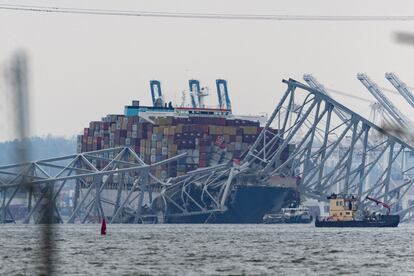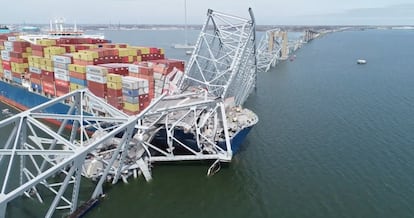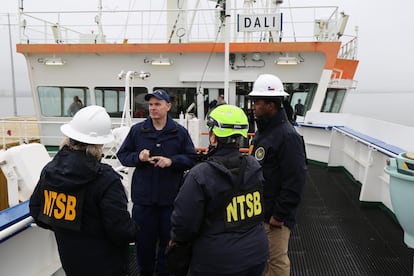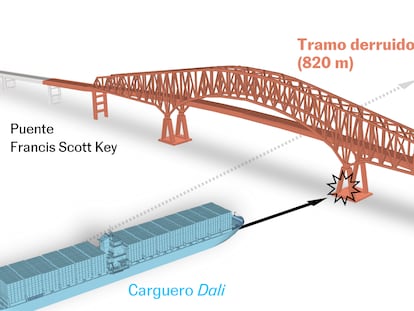Could the Baltimore bridge collapse have been prevented?
Experts say the infrastructure, which was knocked down by a cargo ship, did not have adequate protective measures around its pillars


A terrible accident in 1980 marked a before and after in bridge construction in the United States. On the morning of May 9 of that year, a 607-foot-long container ship collided with the Sunshine Skyway Bridge in Tampa, Florida. A 1,200-foot span of the bridge collapsed as dozens of vehicles were crossing it. Thirty-five people died. The new Tampa bridge, like many others built since then, had protection measures to mitigate collisions and protect the piers. However, the Francis Scott Key in Baltimore — which collapsed last week — opened in 1977 and never had adequate protections. The opinions of experts who spoke to EL PAÍS agree that this could have prevented the collapse of the bridge, which left six people dead and an imposing economic bill. Meanwhile, authorities are investigating why the ship collided with the bridge.
“Although events like this are extremely rare, I am surprised that a protection system was not built for this bridge,” Sherif El-Tawil, professor of Civil and Environmental Engineering at the University of Michigan, and an expert in disaster mitigation, tells EL PAÍS. “The protection system would have diverted the ship from the piers, protected the bridge, protected the community from the loss of a critical bridge and protected the ship itself,” he explains.
The Francis Scott Key was the pride of the city. Immortalized in episodes of The Wire, the cult HBO series that takes place in Baltimore, it was a steel arch-shaped continuous through truss bridge, a triangulated system of straight interconnected structural elements. It was the largest bridge in the city, crossed the Patapsco River and was part of Route 695 and the metropolis’s beltway. Its name honored the author of the lyrics of the ubiquitous United States anthem, The Star-Spangled Banner. The main span, at 1,200 feet, was the third longest in the world. The bridge had a total length of 8,636 feet and was used by almost 12 million vehicles a year, about 33,000 a day.
Since the bridge was built between 1972 and 1977, the size of container ships has grown exponentially, according to logistics firm Allyn International. In 1980, their average capacity was 757 TEU (TEU is the measurement of a standard 20-foot container). Today it has risen sixfold, up to more than 4,400 TEU. And the maximum capacity has gone from the Liverpool Bay’s 2,961 TEU to the 24,346 TEU of the MSC Irina, which was launched in 2023. There are at least 20 ships that go beyond the 20,000 TEU mark.
The ship that collided with the Baltimore bridge is almost 985-feet long and 157-feet wide. The capacity of the Dali — named after Spanish painter Salvador Dalí — is 9,971 standard containers, more than triple the size of the largest ship at the time the bridge was built. “It’s difficult to overstate the impact of this collision we’re talking about. It’s not just as big as a building. It’s really as big as a block — 100,000 tons all going into this pier all at once,” said Secretary of Transportation, Pete Buttigieg, at a press conference at the White House this past Wednesday. It is similar in size to an American Nimitz-class aircraft carrier.
The Singapore-flagged cargo ship cast off after midnight and embarked on what was going to be a 28-day journey to the port of Colombo, the capital of Sri Lanka, where it was due to arrive on April 22. It had been contracted by Danish shipping company Maersk. Managed by two port pilots, it lost propulsion as it approached the bridge for unknown reasons and suffered a total blackout. Reportedly, the emergency generator was launched, but it also failed to turn on the ship’s propulsion.
The tugboats only helped the ship maneuver out of its birth, leaving it to guide itself the rest of the way. That is another point that experts point out: if the tugboats had escorted the Dali beyond the bridge, the accident could also have been avoided. The container ship was adrift for just five minutes, during which time it veered off course, heading directly towards one of the bridge’s two pillars. The port pilots ordered the anchors to be dropped and sent an emergency call via radio. While dropping the anchor did not help stop the ship, the mayday call meant that traffic was cut off before the bridge collapsed, likely saving dozens of lives.
The force of a rocket
When the freighter sailed towards the bridge’s pillar, the die was cast. “The ship was so large that the flared bows came into contact with the pillars and applied an enormous force,” explains El-Tawil. “This caused the failure of part of the A-frame pillars. The weight of the bridge caused the other pillar to collapse. Assuming a tonnage of 120,000 tons and a speed of 6 to 7 knots [between 6 and 8 miles per hour] for the ship, I estimate that the force was on the order of 30 million pounds, 130 million newtons.” This far exceeds the launch force of a rocket. According to NASA, the Space Launch System that launched Artemis 1 was designed to produce 39.1 million newtons at takeoff.
Roberto T. Leon, professor of Civil and Environmental Engineering at Virginia Tech, thinks it unlikely that even a modern and well-designed protection system could have prevented serious damage to the structure due to that enormous momentum. “However, it could possibly have prevented the complete collapse,” he notes. “It is imperative that we update our design codes around the world for these types of events, low probability and high consequences, because container ships have become massive,” says Leon.
The Virginia Tech professor points out that structurally, the bridge was in very good condition, but that in general, in the United States, there are many infrastructures that are poorly maintained and are rarely updated to current codes, because priority is given to repairing the corroded and cracked bridges rather than implementing protection systems.

Jose Adam, professor at the Universitat Politècnica de València in Spain, emphasizes that it is common to protect the pillars or piles in cases of passable channels with a lot of traffic from heavy ships. “These piles were very close to the traversable part, and with inadequate protection,” he indicates, emphasizing that the problem was not the bridge as such. “We cannot design bridges and buildings to withstand all types of extreme events such as vehicle impacts, terrorist attacks, explosions, etc. In many cases, it is advisable to move these infrastructures away from the action that could cause their collapse,” says Adam, a specialist in the protection of critical infrastructures.
By way of example, the professor points to what was changed after the 9/11 attacks. Authorities did not begin to design buildings resistant to the impact of airplanes. The solution, rather, was to prevent them from being hijacked through security controls, protected cockpits and other measures. “In my opinion, the new bridge should have its piers protected from ship impacts. There are two ways to do this: one, protecting them if they remain in the navigable zone, with breakwaters, protection islands, etc. And another, making a bridge with larger spans, that is, greater separation between piers, leaving the piers closer to the mainland where there can be no shipping traffic,” he concludes.
The National Transportation Safety Board (NTSB) is investigating the causes of the Baltimore crash, including the lack of adequate protective barriers. Inspectors have begun to check the condition of the ship, its safety systems and the condition of the crew. They are also analyzing the quality of the fuel, in case poor fuel had caused the power outage. The ship has a kind of black box that records its data and radio conversations. The final report may take more than a year to be published.
“It’s too early to speculate, of course, what NTSB will find, but if they discover or determine anything that should be considered in the regulation, inspection, design, or funding of bridges in the future, we will be ready to apply those findings,” said Buttigieg on Wednesday.

Latin American victims
Vehicles were traveling on the Baltimore bridge until shortly before it collapse. The mayday call from the ship to the port and from the port to the officers allowed the bridge to be closed. “There’s a ship approaching that’s just lost their steering. Until you’ve got that under control, we’ve got to stop all traffic,” an official with the Maryland Transportation Authority told police officers on the ground. One of them, in the radio exchange, warned: “I’m not sure whether there’s a crew up there.” But it was too late.
The eight Latin American workers who were repairing potholes on the bridge road did not receive the warning in time. Two of them survived the collapse. The bodies of two others were recovered from inside a vehicle that sank with the bridge: Mexican Alejandro Hernández Fuentes, 35, and Guatemalan, Dorlian Ronial Castillo Cabrera, 26. The bodies of the other four have not been found yet: Honduran Maynor Suazo, 37, married with two children; Salvadoran Miguel Luna, aged, married with three children, who had lived in Maryland for more than 19 years, according to the CASA organization; Guatemalan José López, 35, and a Mexican individual, whose identity has not been revealed.
In addition to the loss of human life, for Baltimore, the collapse of the bridge has also caused significant emotional and economic damage. The city has lost a landmark, as well an essential route, which was part of the city’s beltroad. Some distances have gone from taking five minutes to 45, and that is not counting the possible traffic on the tunnels that cross the river. What’s more, trucks carrying fuel and other dangerous goods cannot drive through the tunnels, meaning they need to take even longer detours.
In the short term, the situation is even more serious, as the wreckage has created a kind of steel reef that is blocking access to the port, the economic heart of the city. In 2023, its private terminals handled 52.3 million tons of foreign cargo worth $80 billion, Maryland Governor Wes Moore announced last month. It also receives the largest volume of autos and light trucks in the country. Around 850,000 vehicles pass through the port every year. Moore estimates that in addition to the 15,300 direct jobs, 140,000 jobs are linked to port activities.
“The collapse of the Francis Scott Key Bridge in Maryland is another reminder of the US vulnerability to supply-chain shocks,” analysts Oxford Economics said in a report last week. “Ultimately, the duration of the disruptions at the Port of Baltimore, along with how quickly trade can be rerouted, will determine the economic costs.”
Hope now lies in the cranes removing the wreckage. To clear the shipping channel of the mass of steel and concrete, several cranes have been deployed in the area, including one capable of lifting 1,000 tons. Divers must cut the debris to remove it in an operation reminiscent of the game of Mikado or chopsticks. If a piece is removed from prematurely, the whole structure may crumble.
Sign up for our weekly newsletter to get more English-language news coverage from EL PAÍS USA Edition
Tu suscripción se está usando en otro dispositivo
¿Quieres añadir otro usuario a tu suscripción?
Si continúas leyendo en este dispositivo, no se podrá leer en el otro.
FlechaTu suscripción se está usando en otro dispositivo y solo puedes acceder a EL PAÍS desde un dispositivo a la vez.
Si quieres compartir tu cuenta, cambia tu suscripción a la modalidad Premium, así podrás añadir otro usuario. Cada uno accederá con su propia cuenta de email, lo que os permitirá personalizar vuestra experiencia en EL PAÍS.
¿Tienes una suscripción de empresa? Accede aquí para contratar más cuentas.
En el caso de no saber quién está usando tu cuenta, te recomendamos cambiar tu contraseña aquí.
Si decides continuar compartiendo tu cuenta, este mensaje se mostrará en tu dispositivo y en el de la otra persona que está usando tu cuenta de forma indefinida, afectando a tu experiencia de lectura. Puedes consultar aquí los términos y condiciones de la suscripción digital.









































